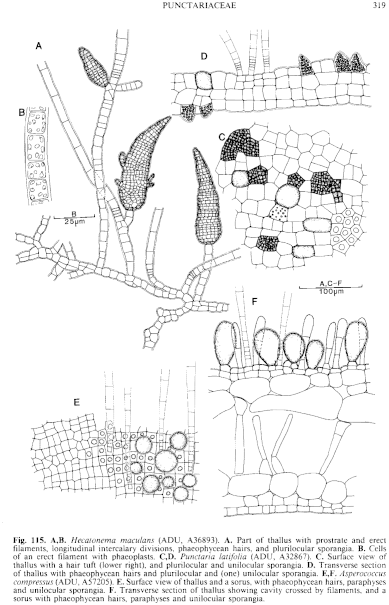|
|
|
|
|
|||||||||||
|
Electronic Flora of South Australia Species Fact Sheet
Phylum Phaeophyta – Order Dictyosiphonales – Family Punctariaceae
Selected citations: Harvey 1846: pl. 72. Knight et al. 1935: 86. Sauvageau 1895: 1, fig. l; 1929: 366, figs 15–17.
Synonym
Haloglossum compressum (Griffiths) Hamel 1937: 225.
Thallus (Fig. 114B) medium brown, flat, 10–20 (–25) cm long, (1–) 1.5–3 (–4) cm broad and 250–500 µm thick with slightly thicker margins, linear or tapering slightly above with a rounded to truncate (often disintegrating) apex, tapering below to a cuneate base, a short slender stipe 3–10 mm long, and with 1–4 (–8) fronds arising from a small discoid holdfast 1–3 mm across; epilithic. Structure with the two membranes lying closely adjacent with a slight central cavity crossed by irregular filaments of long cells (Fig. 115F); membrane 3–4 cells thick, with a cortex of small phaeoplastic cells, several overlying each of the larger inner cells; cortical cells more or less in rows, angular, isodiametric, mostly 8–12 um across in surface view (Fig. 115E), each with several discoid phaeoplasts each with a pyrenoid. Phaeophycean hairs in scattered groups, 8–12 µm in diameter.
Microthallus (Sauvageau 1929) filamentous, branched, haplostichous becoming polystichous.
Reproduction: Sori (Figs 114B, 115E,F) densely scattered over the thallus surface, circular to ovoid, mostly 0.5–1 mm across, containing sessile, ovoid, unilocular sporangia (Fig. 115F) 40–60 µm long and 30–40 µm in diameter, together with slightly clavate paraphyses 2–3 cells long, the end cell 16–22 µm in diameter, and phaeophycean hairs. Plurilocular sporangia rare (Sauvageau 1895, fig. I ).
Microthalli with unilocular and plurilocular sporangia, producing the macrothallus (Knight et al. 1935, p. 87).
Type from Sidmouth, England (Griffiths); in BM.
Distribution: Britain, Europe, Mediterranean, South Africa.
In southern Australia, known only from the two localities below.
Taxonomic notes: A. compressus was first collected and recognised by Dr M.N. Clayton, and it is still known only from the Flinders and Port Phillip specimens. They agree well with the species, and may well be an adventive which has become established on this part of the Victorian coast.
References:
HAMEL, G. (1937). Phéophycées de France. Fasc. III, pp. 177–240. (Paris.)
HARVEY, W.H. (1846). Phycologia Britannica. Plates 1–72. (Reeve: London.)
HOOKER, W.J. (1833). The British Flora. 4th Edn, Vol. 2: Cryptogamia. (Longman: London.)
KNIGHT, M., BLACKLER, M.C.H. & PARKE, M.W. (1935). Notes on the life-cycle of species of Asperococcus. Proc. Trans. Liverpool Biol. Soc. 48, 79–97.
SAUVAGEAU, C. (1895). Sur les sporanges pluriloculaires de 1'Asperococcus compressus Gruff. J. de Bot. 9, 1–3.
SAUVAGEAU, C. (1929). Sur le développement de quelques Phéosporées. Bull. Stn biol. Arcachon 26, 253–420.
The Marine Benthic Flora of Southern Australia Part II complete list of references.
Publication:
Womersley, H.B.S. (14 December, 1987)
The Marine Benthic Flora of Southern Australia
Part II
©Board of the Botanic Gardens and State Herbarium, Government of South Australia
Illustrations in Womersley Part II, 1997: FIGS 114B, 115E,F.

Figure 114 enlarge
Fig. 114. A. Punctaria latifolia (ADU, A54509). B. Asperococcus compressus (ADU, A57205). C. Asperococcus bullosus (ADU, A56299). D. Asperococcus fistulosus (ADU, A57146).

Figure 115 enlarge
Fig. 115. A,B. Hecatonema maculans (ADU, A36893). A. Part of thallus with prostrate and erect filaments, longitudinal intercalary divisions, phaeophycean hairs, and plurilocular sporangia. B. Cells of an erect filament with phaeoplasts. C,D. Punctaria latifolia (ADU, A32867). C. Surface view of thallus with a hair tuft (lower right), and plurilocular and unilocular sporangia. D. Transverse section of thallus with phaeophycean hairs and plurilocular and (one) unilocular sporangia. E,F. Asperococcus compressus (ADU, A57205). E. Surface view of thallus and a sorus, with phaeophycean hairs, paraphyses and unilocular sporangia. F. Transverse section of thallus showing cavity crossed by filaments, and a sorus with phaeophycean hairs, paraphyses and unilocular sporangia.

|
Email Contact: State Herbarium of South Australia |

|